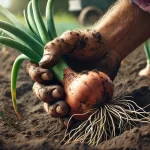Importance of Nutrition in Onion Cultivation
Onion is a crop that demands significant nutrition, as its growth and bulb formation depend on an adequate and balanced supply of nutrients. Proper fertilization management is essential to achieve high yields and good bulb quality. This guide outlines the nutritional requirements of onions and the recommended fertilization strategies to optimize production.
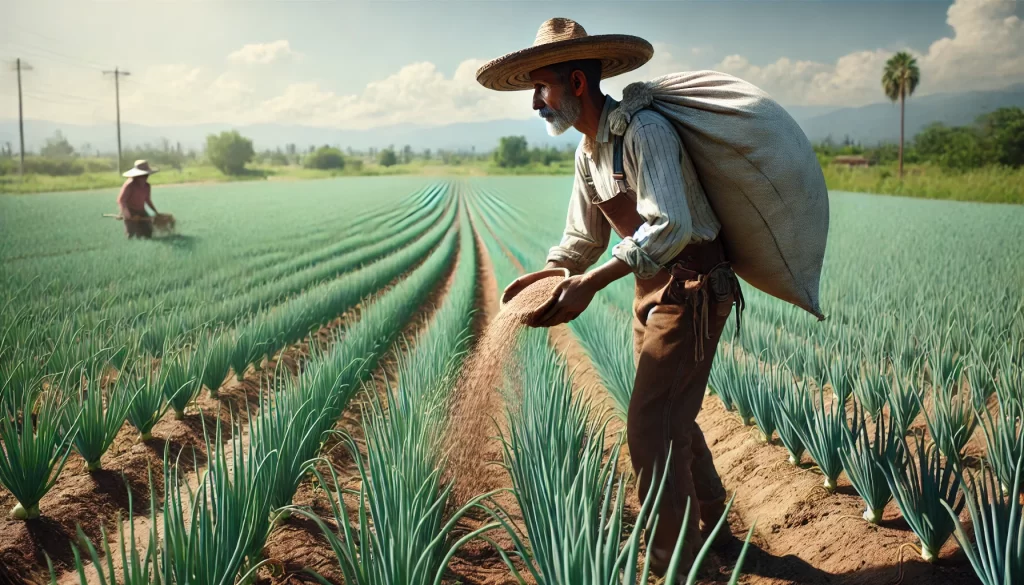
Nutritional Requirements of Onion
Essential Nutrients
Onions need a series of macronutrients and micronutrients for healthy growth and optimal bulb formation:
- Macronutrients:
- Nitrogen (N): Promotes vegetative growth and is crucial during the early stages of the crop.
- Phosphorus (P): Important for the development of strong roots and bulb formation.
- Potassium (K): Improves disease resistance, bulb quality, and water use efficiency.
- Calcium (Ca): Essential for the integrity of cell walls, contributing to bulb firmness.
- Magnesium (Mg): Involved in photosynthesis and chlorophyll formation.
- Sulfur (S): Necessary for amino acid and protein synthesis, also influencing the characteristic flavor of onions.
- Micronutrients:
- Boron (B): Vital for cell division and cell wall formation.
- Zinc (Zn): Involved in the production of essential plant hormones for growth.
- Iron (Fe), Manganese (Mn), Copper (Cu), and Molybdenum (Mo): Required in small amounts for various enzymatic and metabolic functions.
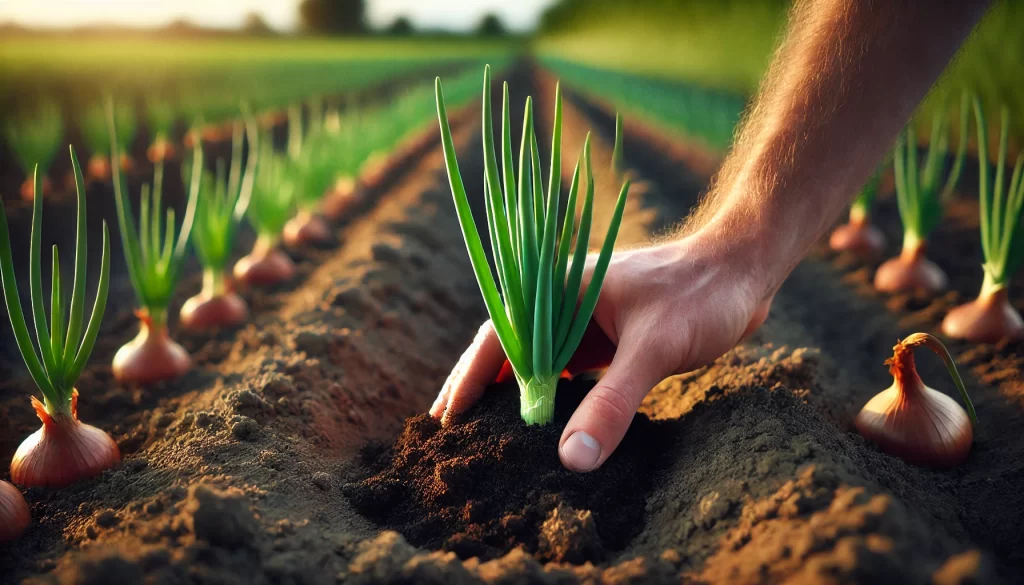
Growth Stages and Nutritional Needs
The nutrient requirements of onions vary throughout their growth cycle:
- Establishment and Vegetative Growth (0-40 days):
- Nitrogen (N): High demand for leaf and stem development.
- Phosphorus (P): Moderate, for good root establishment.
- Bulb Formation (40-90 days):
- Potassium (K): High demand to promote bulb filling and quality.
- Nitrogen (N): Moderate, to avoid excessive foliage growth at the expense of bulb formation.
- Maturation (90 days onward):
- Nitrogen (N): Low, to avoid prolonging vegetative growth.
- Potassium (K): Moderate, to improve bulb resistance to diseases and extend shelf life.
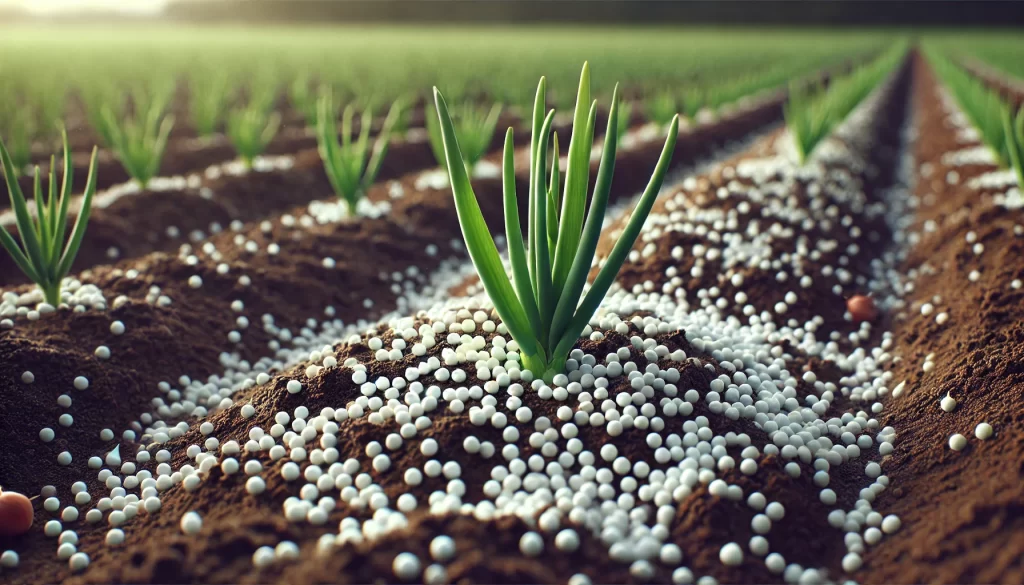
Soil Analysis and Nutrient Diagnosis
Importance of Soil Analysis
A soil analysis before planting is essential to determine nutrient availability and adjust fertilizer applications according to the specific needs of the onion crop.
Diagnostic Methods
- Soil Analysis: Performed to assess levels of macronutrients, micronutrients, pH, and organic matter.
- Foliar Analysis: Allows for adjusting fertilization during the crop cycle, correcting specific deficiencies.
- Visual Indicators: Observation of deficiency symptoms, such as chlorosis or necrosis in leaves, to identify the lack of a specific nutrient.
Fertilization Strategies for Onion Cultivation
Base Fertilization
Base fertilization is crucial to provide essential nutrients from the start of the crop. It generally includes the application of:
- Phosphorus (P) and Potassium (K): In doses based on soil analysis, applied in bands or mixed with the soil before planting.
- Nitrogen (N): Applied in smaller proportions at planting to avoid excessive foliage growth in the early stages.
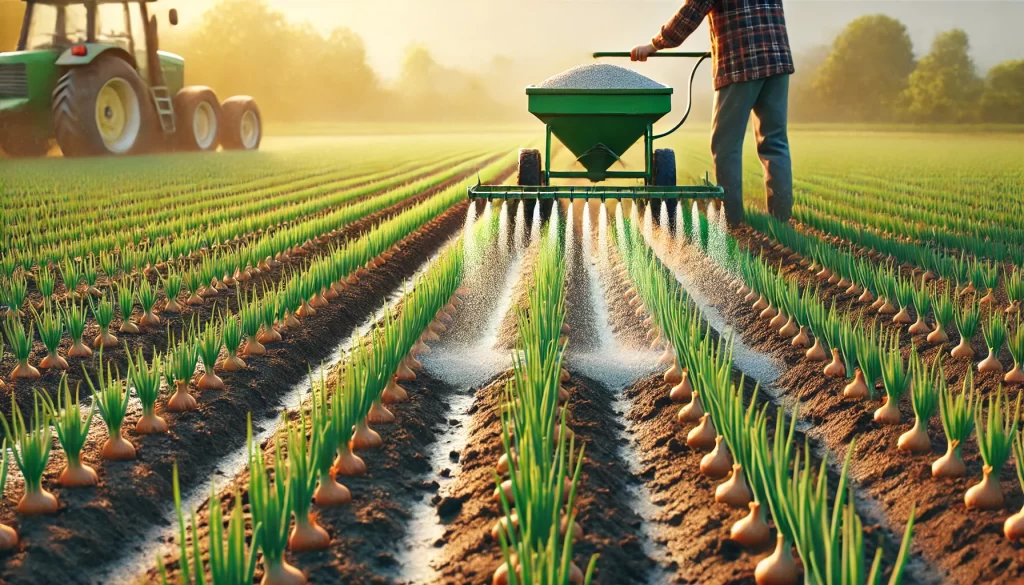
Top Dressing Fertilization
Top dressing fertilization is carried out during the crop cycle to maintain a continuous supply of nutrients:
- Nitrogen (N): Applied at one or more stages during vegetative growth and bulb formation to maintain adequate development.
- Potassium (K): Can be applied during bulb formation to improve the quality and size of the bulbs.
Foliar Fertilization
Foliar fertilization is a complementary technique to correct specific micronutrient deficiencies during the crop cycle:
- Zinc (Zn) and Boron (B): Applied in the early stages of development and during bulb formation to improve plant health.
- Iron (Fe) and Magnesium (Mg): Useful in areas with specific deficiencies or where soil pH prevents the availability of these nutrients.

Management of Organic Fertilization in Onion
Use of Organic Matter
The use of organic fertilizers, such as compost or well-decomposed manure, is beneficial for improving soil structure, increasing water retention, and providing nutrients gradually:
- Composting: Well-decomposed compost is preferable to avoid nitrogen competition that can occur with fresh materials.
- Manure Application: Should be well-distributed and preferably applied before planting to allow decomposition and avoid introducing pathogens.
Green Manures
Green manures, such as legumes and oats, can be sown before the onion crop to improve soil fertility and naturally provide nitrogen.
Fertilization Adjustments Based on Climate and Soil Type
Adaptation to Different Climatic Conditions
Fertilization management should be adjusted according to the climatic conditions of the region:
- Cold Zones: Increase phosphorus and potassium to strengthen plants against low-temperature stress.
- Humid Zones: Greater emphasis on potassium to reduce the risk of fungal diseases and improve storage resistance.
Considerations by Soil Type
- Sandy Soils: Require more frequent nutrient applications due to their low water and nutrient retention capacity.
- Clay Soils: Better nutrient retention but may require pH adjustments and careful irrigation management to avoid compaction.

Tools and Technologies for Onion Fertilization
Precision Agriculture
The use of precision agriculture technologies allows for more efficient fertilizer application:
- Soil Sensors: Monitor moisture and nutrients in real-time, allowing immediate adjustments.
- Drones and GPS: Help map the field and apply fertilizers variably according to the needs of each area.
Controlled-Release Fertilizers
Controlled-release fertilizers are a modern option to improve nutrient use efficiency, reducing leaching and ensuring a constant release throughout the crop cycle.
 AgronoBlog – Agriculture Blog
AgronoBlog – Agriculture Blog 

